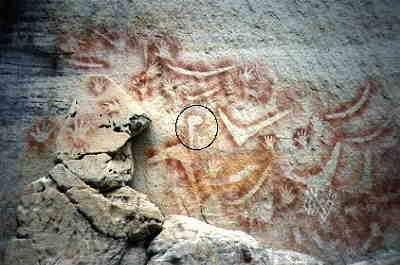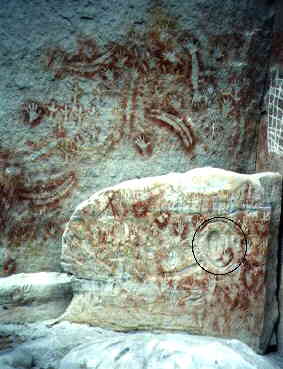TRACCE no. 4 – by Chris Kirtley
Aboriginal Rock Art, Carnarvon National Park, Queensland, Australia
Carnarvon Gorge, near the town of Roma (some 400 km west of the Queensland State capital of Brisbane), is something of a shangri-la.

Rock paintings in Cathedral Cave
Massive sandstones rise out of the dry plains, and their erosion over centuries has formed a maze of beautiful gorges foliated by ancient palms. It is thus not surprising that Aboriginal people once inhabited these ranges, leaving a fascinating legacy of rock engravings and paintings. The gorge is now a protected National Park, administered by the Queensland National Parks and Wildlife Service.
The uplands in general have been occupied for at least 19,000 years, but intensive use of the area did not take place until 4-5,000 years ago. The art styles and motifs indicate that the area was occupied by people closely associated with the Bidjara tribe, who were known to inhabit the headwaters of the Warrego River. These Aborigines had a diversified economy based on many plants and animals. The most important of the animal foods was the rock wallaby (small kangaroo), whose burned bones have been found throughout. Trade links stretched as far as Cape York (Far North Queensland).
By far the most important plant food was the seeds of the zamia (Macrozamia moorei), which are still numerous in the park, and provided a rich starch and protein supplement to the diet during dry winter months when other food was scarce.
Seeds of this plant are highly poisonous in their native state and require a complicated process to remove the toxin. Relatives of this plant are still eaten today throughout the tropics and sub-tropics.
Many small art sites are scattered throughout the park, but the main sites are Cathedral Cave and the Art Gallery.
Cathedral Cave
Cathedral Cave is a massive rock shelter with an extensive floor area and high arched ceiling, facing Carnarvon Creek.
It contains a tremendous array of art
Stencil art is the dominant style: created by the artist blowing ochre mixed with water from his mouth aerosol-like over an object held against the rock. Flat objects thus result in a clearly defined outline, while rounded or bulbous items permitted underspray and a blurred outline.

Lil-lils and adult hand-stencil in Cathedral Cave
Hands are the most common motif (as in many other Australian rock art examples), but stencil boomerangs and weapons are also prominent.
One of these is the so-called “lil-lil” (circled), a club shaped like a boomeerang with a hump on its reverse. These are different to all any other known lil-lils (which normally have the hump on the forward surface of the club).
Red and mauve ochres (haematite, with some magnesium content) are the predominant colours, with a small amount of yellow (limonite, hydrated iron oxide), black (pyrolusite, manganese dioxide) and white (kaolin clay). White appears to be a more recent development, often being applied over the other colours.
The pigments do not fade with age, and have been radio-carbon dated to about 3,500 years ago. Similar ochre finds in nearby Kennif Cave have been dated to 18,000 years and are among the oldest in Australia. Some off the hand stencils are distorted, and thought to be ‘signal’ stencils, a form of stenciled sign language.
Two lil-lils and adult hand-stencils around a small hole in the wall high above the rock-fall area (picture on the right) are thought to be burial art,since a bark burial cylinder containing the remains of a child was removed from a nearby hole by an early European visitor to the gorge.
The Art Gallery

Rock paintings in the Art Gallery
This is the park’s most interesting display, and the bright atmosphere and pleasant setting add to the attraction of one of the finest selections of stencil rock art in Australia.
There are boomerangs of all shapes and sizes, varying from large V-shaped 'killer' versions to small leaf-shaped hunting versions, together with shields (coolamons) and a range of stone tomahawks. Some of the boomerangs are in matched-pairs, manufactured to identical size and weight. If the hunter missed with his first weapon, he had a second to make another recalculated throw.
We know that this was not a single boomerang duplicated, since some pigment overspray would be evident in one stencil outline. There is some freehand art, too, with a large white net pattern created by applying pigment with the finger or a fibrous brush made from a chewed twig. Amid the ochre art, examples of pecked engravings are also identifiable. The frequent depiction of a female vulva (circled) appears to be associated with a fertility rite, probably forming part of a ceremony.
Lecturer in Bio-engineering – Curtin University of Technology
GPO BOX U1987 – Perth 6001
Western Australia – fax +9 351 3636















Leave a Reply